2008 Lexus IS350 Review
By Chris Haak
05.20.2008
Even before I started writing about cars and the car business, I’d driven hundreds of different vehicles over the years. Some stood out – 1969 Firebird 400 four speed, any Chevy Corvette for instance – while some did not, such as a 1987 Buick Century on its way to a wholesale auction. Some were enjoyable to drive, and some were numb and disengaged. Some had adequate power, some were underpowered, and a select few had just enough power. The 2008 Lexus IS350 was one that did everything just the way I expected it to, and one of the rare vehicles that I genuinely missed driving the day after the representative from Lexus picked the car up. All that being said, the IS350 wasn’t perfect or very practical for any families, and in fact, I probably wouldn’t buy one myself.
Exterior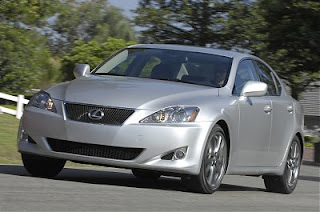 The IS350 is a very well-proportioned vehicle. It has short overhangs both front and rear, and features Lexus’ so-called L-Finesse design language. Although I’ve never seen a written definition of exactly what L-Finesse means, I’ve noticed that certain parts of Lexus automobiles have sharp points on the outer border with rounded edges on their inner border (for example, look at the shape of the IS350’s grille). Styling experts would also tell you that L-Finesse also means a blending of “slashing, angled forms balanced against the curving fluid surfaces.” Whatever it means, it looks Asian, yet not derivative of any other manufacturer’s vehicles. Lexus took a lot of criticism early in its existence for building a better, cheaper Mercedes-Benz, and while it took the company quite a while to find its styling mojo, I’m pleased with the results.
The IS350 is a very well-proportioned vehicle. It has short overhangs both front and rear, and features Lexus’ so-called L-Finesse design language. Although I’ve never seen a written definition of exactly what L-Finesse means, I’ve noticed that certain parts of Lexus automobiles have sharp points on the outer border with rounded edges on their inner border (for example, look at the shape of the IS350’s grille). Styling experts would also tell you that L-Finesse also means a blending of “slashing, angled forms balanced against the curving fluid surfaces.” Whatever it means, it looks Asian, yet not derivative of any other manufacturer’s vehicles. Lexus took a lot of criticism early in its existence for building a better, cheaper Mercedes-Benz, and while it took the company quite a while to find its styling mojo, I’m pleased with the results.
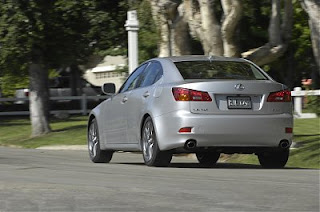 The car has the high door sills and short window openings that are in vogue today (though they didn’t bother me as much as they did in the Lincoln MKZ, a larger car that seemed to swallow me within its high door sills). The doors are almost completely flat except where they curve inward toward the glass at the sills and where they bulge around the wheel openings. The wheels on my test vehicle were 18 inch alloys and had low-profile performance tires mounted to them. Perhaps because the IS350 is rear wheel drive only, or perhaps Lexus just “gets it,” but the wheels filled the openings perfectly. They didn’t look too large or too small, and didn’t have too much distance between the tops of the tires and the center of the wheel opening in the fenders. There is a great-looking line that flows from the base of the windshield, across the hood in a V-shape, past the perimeter of the grille, and into the front bumper. It really works for the car as a unifying element. The headlights are basically a triangular shape prevalent among many Asian vehicles, and the taillights are angled downward toward the center of the car, which makes the back of the car look almost “angry” if one imagines that the lenses are eyebrows. To me, the front end is more successful than the back end, styling-wise, but that may be partially because of my disappointment in the lack of taillight creativity in this second-generation IS. The first generation IS (the IS300) started the “Altezza lights” trend several years ago. (The first-generation IS was sold in Japan as the Toyota Altezza, and was one of the first production vehicles to feature an inside lamp housing finished in chrome with the actual illuminated portion of the lamp the only part in red; subsequently, “Altezza lights” could be found as aftermarket accessories on everything from Chevy Suburbans to Dodge Neons and Honda Civics; in fact, several automobile manufacturers equipped their own new vehicles with Altezza-like lights, such as GM with the Chevy Equinox and Aveo, and Ford with the Fusion). Suffice it to say that the closest the current IS will get to having its taillight design emulated is the similar shape of the Mitsubishi Lancer’s lamps.
The car has the high door sills and short window openings that are in vogue today (though they didn’t bother me as much as they did in the Lincoln MKZ, a larger car that seemed to swallow me within its high door sills). The doors are almost completely flat except where they curve inward toward the glass at the sills and where they bulge around the wheel openings. The wheels on my test vehicle were 18 inch alloys and had low-profile performance tires mounted to them. Perhaps because the IS350 is rear wheel drive only, or perhaps Lexus just “gets it,” but the wheels filled the openings perfectly. They didn’t look too large or too small, and didn’t have too much distance between the tops of the tires and the center of the wheel opening in the fenders. There is a great-looking line that flows from the base of the windshield, across the hood in a V-shape, past the perimeter of the grille, and into the front bumper. It really works for the car as a unifying element. The headlights are basically a triangular shape prevalent among many Asian vehicles, and the taillights are angled downward toward the center of the car, which makes the back of the car look almost “angry” if one imagines that the lenses are eyebrows. To me, the front end is more successful than the back end, styling-wise, but that may be partially because of my disappointment in the lack of taillight creativity in this second-generation IS. The first generation IS (the IS300) started the “Altezza lights” trend several years ago. (The first-generation IS was sold in Japan as the Toyota Altezza, and was one of the first production vehicles to feature an inside lamp housing finished in chrome with the actual illuminated portion of the lamp the only part in red; subsequently, “Altezza lights” could be found as aftermarket accessories on everything from Chevy Suburbans to Dodge Neons and Honda Civics; in fact, several automobile manufacturers equipped their own new vehicles with Altezza-like lights, such as GM with the Chevy Equinox and Aveo, and Ford with the Fusion). Suffice it to say that the closest the current IS will get to having its taillight design emulated is the similar shape of the Mitsubishi Lancer’s lamps.
Interior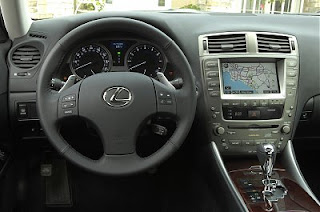 Lexus’ bread and butter is the design and materials found in their vehicle interiors. Even in their sporty models such as the IS, they take pride in the luxury, comfort, and ambiance that the interior surroundings provide. To that end, the IS350 that I tested featured heated and cooled seats with very soft leather, a navigation system with backup camera, Bluetooth cell phone connectivity, electroluminescent gauges, a power moonroof, wood interior trim, a power rear sunshade, XM Satellite Radio, and a smart key with pushbutton start. The dash was nicely padded and all instruments and controls fell right to hand. Lexus clearly sweated the details in the interior; rather than having a dark abyss between the seats and console, for example, the IS had an upholstery covering to catch things that fell through.
Lexus’ bread and butter is the design and materials found in their vehicle interiors. Even in their sporty models such as the IS, they take pride in the luxury, comfort, and ambiance that the interior surroundings provide. To that end, the IS350 that I tested featured heated and cooled seats with very soft leather, a navigation system with backup camera, Bluetooth cell phone connectivity, electroluminescent gauges, a power moonroof, wood interior trim, a power rear sunshade, XM Satellite Radio, and a smart key with pushbutton start. The dash was nicely padded and all instruments and controls fell right to hand. Lexus clearly sweated the details in the interior; rather than having a dark abyss between the seats and console, for example, the IS had an upholstery covering to catch things that fell through.
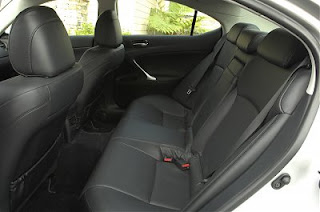 Unfortunately, the interior is also severely lacking in the roominess department, particularly in the back seat. Part of the problem is inherent with rear wheel drive-based vehicles; they require a large driveline tunnel on the floor, and part of the problem is because the front seats are so thick and comfortable that they are occupying some of the real estate that would otherwise probably go toward the rear seat’s area. Another problem personally with small-ish vehicles such as the IS is that, at 6’4″, I need to have the seat adjusted to a point near the rearmost point in its travel. The end result was that, although I was able to install our child seats (a booster for our older son and a rear-facing convertible seat for our infant son), the front passenger seat had to be adjusted so far forward that it was nearly impossible for my wife (at 5’11”) to spend more than 15 minutes in that seat at a time. Also, the trunk would only hold a single Graco stroller, and left very little remaining space for anything else. For example, a golf bag or small suitcase would not fit into the trunk if the stroller was already there.
Unfortunately, the interior is also severely lacking in the roominess department, particularly in the back seat. Part of the problem is inherent with rear wheel drive-based vehicles; they require a large driveline tunnel on the floor, and part of the problem is because the front seats are so thick and comfortable that they are occupying some of the real estate that would otherwise probably go toward the rear seat’s area. Another problem personally with small-ish vehicles such as the IS is that, at 6’4″, I need to have the seat adjusted to a point near the rearmost point in its travel. The end result was that, although I was able to install our child seats (a booster for our older son and a rear-facing convertible seat for our infant son), the front passenger seat had to be adjusted so far forward that it was nearly impossible for my wife (at 5’11”) to spend more than 15 minutes in that seat at a time. Also, the trunk would only hold a single Graco stroller, and left very little remaining space for anything else. For example, a golf bag or small suitcase would not fit into the trunk if the stroller was already there.
On the Road
Once I left my family behind and used the Lexus by itself, I came to appreciate – dare I say love – driving the car. Most professional reviewers who have driven both the BMW 3-series and the current IS have concluded that the IS isn’t quite sporty enough, and that the 3-series isn’t the benchmark. However, since I haven’t driven a 3-series for almost a dozen years (and never for a week), I didn’t have the benefit of that relative comparison. Instead, my basis for comparison was any number of front wheel drive-based sedans that I’d driven over the years: Honda Accord, Toyota Camry, Lincoln MKZ, Mercury Sable, Pontiac Grand Prix, etc. Compared to any of these vehicles, the IS350 was faster, handled better, looked better, and even sounded better. With the traction control switched on, in fact, it even did fine on wet roads with its summer tires. 306 horsepower is pretty lofty for such a small car, and while the car was extremely quick, I never once felt that it was too much power to effectively put to the pavement.
The routine when starting the IS350 with the smart key is identical to the steps taken in either the Prius or Camry Hybrid (with the key fob in your pocket, open the door, press the brake pedal, and push the Power button). The difference is, pressing the Power button in the IS gives a rumble and a growl, while it was greeted by some beeps and whirs – but no internal combustion engine – in the hybrids. Both the speedometer and tach needles swing to their full travel point for a second, then return to 0 mph and 600 RPMs, respectively. The steering wheel was thick, perfectly finished in satin-finish charcoal leather, and had a delightfully small diameter. I don’t heap praise lightly on steering wheels, because I can’t stand them when they are shiny, have protruding stitching (or even worse, aren’t covered in leather), or are too large. But the IS350’s tiller was the perfect size to handle, while remaining sufficiently large to perfectly encircle the gauge cluster for easy visibility of the pertinent information. Behind the steering wheel are paddle shifters, with the upshift paddle on the right (labeled ‘+’) and the downshift paddle on the left (labeled ‘-‘). I’m not sure if they were magnesium or another metal, but they were definitely not plastic, and felt great with their matte finish.
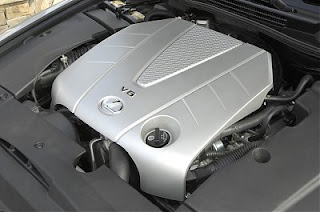 As the car idled, a subtle “tick-tick” sound was barely audible under the hood. This is a trait inherent with all gasoline direct injection engines. It wasn’t annoying to me, but I could hear it. Perhaps less trained ears wouldn’t even notice it (in spite of having far better hearing overall, my wife couldn’t notice it, and she also can’t hear valvetrain noise in our Sienna when the engine isn’t warmed up). I knew to listen for it, so that might be why I was able to notice it. The sound disappears as the engine revs higher, but is still audible at very slow parking lot-like speeds as well.
As the car idled, a subtle “tick-tick” sound was barely audible under the hood. This is a trait inherent with all gasoline direct injection engines. It wasn’t annoying to me, but I could hear it. Perhaps less trained ears wouldn’t even notice it (in spite of having far better hearing overall, my wife couldn’t notice it, and she also can’t hear valvetrain noise in our Sienna when the engine isn’t warmed up). I knew to listen for it, so that might be why I was able to notice it. The sound disappears as the engine revs higher, but is still audible at very slow parking lot-like speeds as well.
Beyond the parking lot or driveway, however, the IS350 is very nearly a beast, albeit a tame one. Flooring the throttle brought an instant multi-gear kickdown of the six-speed automatic and a rush of acceleration. On curvy roads, if I was feeling playful, I could engage the manual shift mode of the transmission and the paddles would hold their gear up to the rev limiter. I’m personally far more used to either driving a conventional manual or automatic transmission, so I actually preferred switching the throttle/transmission algorithm from Normal to Sport (the other choice is Snow, which severely dulls throttle response but might save your RWD Lexus on a slippery day). Sport mode with the transmission allowed to shift itself caused the transmission to hold its gear for several seconds, even after lifting the throttle. It’s obviously not great for fuel economy, but great if you have to lift briefly for a curve and want to get right back into the engine’s powerband without waiting for the transmission to get back into the proper gear.
On those curvy roads, the electric power steering was probably the car’s only weak point; while it felt better than any other Toyota product’s steering, it felt a little artificial. Effort was slightly higher than expected at speed, and it seemed to lack a little bit of on-center precision. However, given a choice between a higher than expected effort and a lower than expected effort, I’d take the higher effort any day, as I can’t stand overboosted power steering.
The IS was comfortable even over rough road surfaces; it managed to recover quickly from large bumps with no floatiness. I never understood why some luxury cars, all in the name of “comfort” forced occupants to endure the same bump multiple times as the car continued to rebound. The IS, as it’s focused more on the sport side of the spectrum, doesn’t have that issue. Braking was excellent; since I obviously did not race the car or take it to a track, I cannot comment on whether it fades under repeated heavy use, but the large four wheel discs and large, grippy summer tires combined forces to stop the car quickly and drama-free. The brake pedal’s feel might be an adjustment for some; the top of its travel begins applying braking force, and full ABS engagement at the end of its travel is only seemingly about two inches from the beginning of travel. Therefore, drivers will have to re-calibrate their right foot for different braking engagement than they may be used to, although I didn’t have any problem adjusting to or from the IS350’s pedal.
Fuel Economy
The only problem with driving a fast, desirable car is that it’s extremely tempting to dip into its ample power reserves more often than someone like your mother would appreciate you doing. Passing on a two-lane? Sure, just floor it! Annoyed by someone on the highway? They’re now in your rearview mirror. But this fun has a price, and that’s an observed 17 miles per gallon. I also blame more annoying stop-and-go traffic than usual on my daily commute last week. By the way, it requires premium unleaded, too. The EPA rates the IS350 at 18 city/25 highway, and I find both of those ratings to be reasonable; during some highway jaunts, mid-20s are very do-able if you can move on, say, 75 of those 306 horsepower. Start summoning them, however, and the mpgs drop rapidly. The RWD automatic IS250 sedan is rated at a better 21 city/29 highway, but is also about 100 horsepower down from the IS350, and therefore loses most of the reason to buy a new IS. Finally, the new IS-F, with a 400+ horsepower 5.0 liter V8, is rated at 16 city/23 highway.
Pricing
The base price of the IS350 I tested started at $35,905. My test vehicle had a lot of options, though not all of them. Options on my tester included the luxury package with 18″ wheels ($4,325), navigation system ($2,550), intuitive parking assist with front and rear sensors ($500), and XM satellite radio ($486). With destination and a few other minor options, the final MSRP came to $44,828. Two major options that weren’t included on my test vehicle included laser dynamic cruise control with a pre-collision system ($2,850), and a 14-speaker Mark Levinson audio system ($1,440 on top of the $2,550 navigation system, which is required). It’s a lot of money, but it’s also a premium (albeit small) product. Even though the car is similar in size to a Civic, it also packs a lot more expensive technology and content under its skin than a Civic does. Is it worth $45,000? I’d seriously consider it (after testing a G35s, 335i, and CTS DI) if it weren’t for the lack of interior space. The 335i would probably give similar space problems, while the G35 is a bit bigger, and the CTS is much bigger.
Bottom Line
The IS was a heck of a car. Anyone in the market for a quick, comfortable, attractive entry luxury/sport sedan should absolutely give the IS350 strong consideration. If a potential customer is 5’8″ instead of 6’4″, it might just be the perfect vehicle for him.
COPYRIGHT Full Metal Autos – All Rights Reserved




